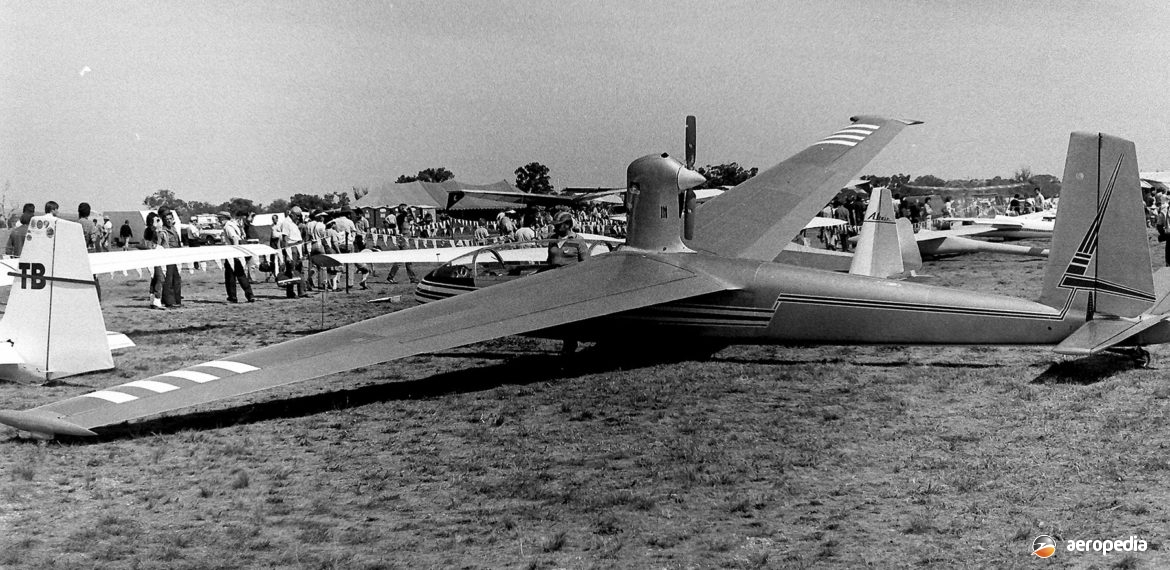Photograph:
A Blanik L-13J powered glider at Mangalore, VIC in 1983 (David C Eyre)
Country of origin:
Czechoslovakia
Description:
Self-launched glider
Power Plant:
One 56 kw (76 hp) Walter Mikron IIIAE four-cylinder inverted in-line air-cooled engine
Specifications:
- Wingspan: 16.2 m (53 ft 2 in)
- Length: 8.4 m (27 ft 7 in)
- Height: 2.09 m (6 ft 10 in)
- Wing area: 19.15 m² (206.1 sq ft)
- Never exceed speed: 240 km/h (149 mph)
- Stalling speed with no flaps:62 km/h (39 mph)
- With 10 degrees flaps: 56 km/h (35 mph)
- G limits: +5 / -2.5 at 136 km/h (84 mph)
- Max glide ratio at 93 km/h (58 mph): 28.2
- Rate of sink at 83 km/h (52 mph): 50 m/min (165 ft/min)
- Empty weight: 292 kg (644 lb)
- Loaded weight: 500 kg (1,102 lb)
History:
The Blanik L-13 glider was a two-seat trainer produced by Let Kunovice (LET) in Czechoslovakia in the 1950s, the prototype making its first flight in 1956. More than 3,000 examples have been delivered in a variety of models over many years. It is said to be the most widely used glider in the world and was operated for some years by the United States Air Force Academy as the TG-10C. Most examples were non-powered but a few have been powered.
The aircraft was designed by Karel Dlouhy following experience gained using laminar flow wing designs and it was aimed at the market as a glider for basic flight instruction, instruction in aerobatics, and cross-country training. It was of metal construction and once in production in 1958 became popular due to its inexpensive cost, its rugged construction and ease to operate and fly. It was used extensively in the Soviet Union and was used to set a number of cross-country records during the 1960s. It eventually was developed to the Aerotechnik L-13 Vivat.
The fuselage was of semi-monocoque construction using longerons and bulkheads with an ovoid cross-section. The wings were tapered with forward sweep and were of single-spar, all-metal construction. The flaps and ailerons had a metal frame and were covered with fabric. DFS spoilers were fitted to the upper and lower wing surfaces. The undercarriage was semi-retractable with an oleo-pneumatic shock absorber. Following a wing-spar failure in Austria restrictions were placed on several models in 2010, including approval to perform aerobatics being withdrawn.
During the 1970s the Australian Gliding Federation investigated the potential fatigue life of the Blanik. The Ansett Airlines NDT laboratory and the Australian Civil Aviation Authority developed an inspection program for the type. Riley Aeronautics then received from the Department of Aviation authority to carry out a modification of the wing to extend its fatigue life, nine Blaniks in Australia being re-certified as the L-13A1.
Variants of the series were the L-13AC, L-13J, L-13TJ fitted with a TJ100C jet engine for take-off, L-13B with a Walter Mikron IIIA engine, and the L-13 Vivat built by Aerotechnik being a touring variant with either a Walter Mikron IIIAE four-cylinder in-line engine or a Limbach L2000 four-cylinder horizontally-opposed engine. In 1969 a quantity of powered variants known as the L-13J was produced, these being fitted with an Avia M150 Jawa three-cylinder engine producing 31 kw (42 hp).
A number of examples of the Blanik have operated in Australia over the years, most being non-powered variants, but at least one powered model has operated in Victoria, this being the L-13J model. Examples have also been operated by the Air Cadets School of Aviation Inc at Archerfield, QLD, being operated by No 2 Wing AATC, these being L-13s VH-GVD (c/n 174618), VH-GVK (c/n 174815), and VH-HDV (c/n 174912), all being non-powered variants.

